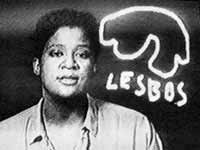|
 
Photograph
#1 Jennifer Jones with L's
Preserving
Desire
On September 22, 1991, L is for the way you look premiered
as a benefit for the Lesbian Herstory Archives Building
fund. The benefit was held at the Lesbian and Gay Community
Center.
Photo #2 Val w/ Lesbos map
(captlon)
"To name us one goes by way of reference to the poet
Sappho, which in turn is an indirect reference to the poet
Sappho, (who used to live there they say), which in turn
is itself an indirect reference to what fragments of her
poetry have survived a few millennia of patriarchy and this
in turn,(if we haven't lost you by now) is a prophylactic
avoidance of direct mention of the sort of creature who
would write such poems, or, to whom such poems would be
written." -- Marilyn Frye from The Politics of Reality.
Even before
L is for the way you look was completed, I knew I
wanted to premier it as a benefit for the Lesbian Herstory
Archives. As I write this, the Archives is preparing to
purchase a new building that would allow it to grow out
of Joan Nestle's West Side apartment into a cultural center.
The screening was to be part of an organizing strategy to
raise money for the purchase of the building.
Since the Archives have always chosen to exist independent
of city, state or federal funding, it must rely on community
support. The Archives eschewal of federal, state and city
funding is not surprising. There has always been varying
degrees of manipulation and censorship attached to this
money. Imagine what would be lost if lesbians entrusted
our histories to a dominant culture: the history of women
of color, passing women and sex workers. There would be
the loss of the personal detail: the diaries, stories of
first kisses, descriptions of lesbian bars of another era
and stories of daily struggle. Our lives are impoverished
when these details are lost, forgotten or destroyed.
"How could gay
people have a memory of themselves as a people with a history
when, for many years, our only social existence was on the
pages of medical, psychological, legal and religious texts
-- all dedicated to proving our pathology. It is not that
our people did not speak, but their words and their lives
lived in the context of the colonizer."
-- Joan Nestle from When Lions Write History
L is for
the way you look was made because I didn't want to forget
this period of my life, or this point in time. It's like
a diary. It shows a period in my life when I actively chose
to stop trying to find myself represented on television,
to go outside and see what is happening in the world, to
become an activist, to make television about my friends
and community. Each woman in it participated candidly because
they too felt their perceptions and insights were worth
preserving. The desire to preserve a history and give validation
to our lives is crucial towards constructing our identities.
The idea first came to me for L is for the way you
look at a party when somebody said that they saw Dolly
Parton at Reno's show at PS 122. Since Reno initially became
popular among lesbians and gays, Dolly's presence sparked
considerable interest and questions. In fact, once this
topic came up, the party changed completely. There were
no more separate conversations, only one central one that
was guided by various renditions of what really happened
that night. The individual re-tellings of the event by the
women who had seen her, created a narrative from a lesbian
perspective which I found provocative to explore. It reminded
me of Kurosowa's Rashomon.
The discussion of Parton's presence at this event was
more complicated than: "is she a lesbian or not?" Although
these women readily engaged in a spirited discussion about
the event, their excitement was tempered by the fact that
Dolly has never identified herself as a lesbian. Instead
of proving anything about Parton's sexual orientation, it
pointed to larger questions of lesbian identification. Dolly's
presence became analogous to dyes injected into cells under
a microscope, to make them more visible.
I wanted to preserve
lesbians' perceptions of this event. My desire for women
has always been nourished by efforts to preserve meaningful
events and artifacts. Since lesbian culture has been scorned
and deemed worthless by dominant culture, I grew up keeping
scrap books, hiding items in shoe boxes hidden under my
bed, keeping a secret diary, cherishing the remembrance
of a gesture all night long in my mind. My work in video
has always satisfied me most when it duplicated these early
efforts to duplicate my desire.
The new Lesbian Herstory Archives building presents an exciting
opportunity to make a contribution to what should never
be taken for granted. As the urge to preserve our past grows
our communities are strengthened. Young lesbians have more
options to influence what they do think or say. Older lesbians
have a place where their past is preserved. Lesbians from
out of town have a friendly place to come and meet the locals.
"My heart is
moved by all I cannot save, so much has been destroyed.
I have to cast my lot with those who age after age, perversely,
with no extraordinary power, reconstitute the world."
-- Adreinne Rich from Natural Resources
When I delve
into the resources at the archives, I feel the same excitement
as when I see my lovers face after a relatively long separation.
I feel as if I've come home.
Let me tell you
something,
There will be a few,
Who will remember us.
-- Sappho
|